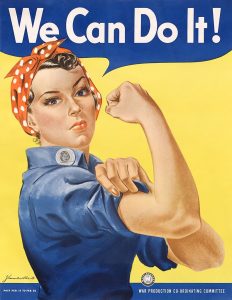No, this isn’t a trendy “International Women’s Day” post (but I love one tweet I saw: “There is absolutely no symbolism more perfect than International Women’s Day being 23 hours long.” —Elaine Filadelfo. Thanks, Daylight Saving Time!)
When an idea needs a special “day” to recognize it, and otherwise the topic is essentially ignored, then a “day” isn’t enough. For me, every day is International Women’s Day.
So while this wasn’t prompted by IWD, it fits right in. It’s one reader’s reaction to a story in last week’s issue, so let’s start with that:
Can We Do It?
The Canadian Armed Forces has formed a “Tiger Team” to help increase the number of women serving — from 15.9 percent now to 25 percent by 2026. Analysts say women are reluctant to join the military because they have a “discomfort with a profession that involves combat,” and have concerns about sexual harassment. “[S]ystemic barriers remain in place, making the military a less than desirable choice for the majority of young Canadian women,” the team says. To reach the goal, they suggest recruiting initiatives highlight the social and entertaining aspects of life in the services, with proposed social media posts like “My bling are my medals” and “My war paint is camouflage.” They also suggest including more women on the Canadian military’s Dress Committee, which is now “composed of middle-aged males whose outlook is not reflective of current trends amongst the target demographic.” The team recommended modifications to the women’s uniforms, such as making the skirt shorter and slimmer. (MS/Ottawa Citizen) …Sounds like the “Tiger Team” is composed of middle-aged males whose outlook is not reflective of current trends amongst the target demographic.

“MS” is True contributor Mike Straw, retired from a career in the U.S. Air Force.
The “Can We Do It?” slug, by the way, is a reference to the classic wartime poster illustrated here.
Sometimes I don’t need to say anything about a story because a reader who has “been there” says it all so very, very well. In this case, that’s Michelle in Oregon. But I’ll note right up front the title is mine, not hers.
Michelle’s Comments
Regarding the story about the Canadian Armed Forces’ desire to recruit more women: I joined the Marine Corps while I was a senior in high school in order to get money for college. Before speaking with the recruiter, I had no idea women were even allowed in the Marine Corps. I’d originally planned to visit the Air Force recruiter, but their office was closed — I couldn’t tell if it was closed for lunch or they were no longer recruiting in that area — and a Marine recruiter saw me in the hallway and approached me.
Why didn’t I know that women have been part of the Marine Corps since WWI until after I’d already joined? I’d simply never seen any pictures of women in a Marine uniform. If the Canadian Armed Forces — or any organization, for that matter — wishes to recruit more women to their cause, they should heavily publicize that women are already involved. Publish pictures of women training, performing their jobs, and women in leadership roles.
My husband and I were just discussing the relatively high number of women who ran for president during the Democratic Primary. This will lead to more and more women running for office.
A few months ago, I listened to a podcast episode published by the Godless Bitches where they were discussing why women should have to register for the draft for the purpose of equality. They concluded that evangelicals in the U.S. would do away with the draft altogether, rather than admit that women were equal to men. (I believe we no longer even need the draft because the U.S. is wealthy enough to attract and retain service members through bonuses — sign-on bonuses, re-enlistment bonuses, etc.)
The subject of the draft had up until then always been a sore point for me, probably because I was raised a conservative Mormon and I’d never heard women advocating for it. The subject would occasionally come up while I was on active duty and it sounded like a threat to me. One of the women involved in the GB discussion said that looking back on her military service, she recognized that the military gave her opportunities that she never would have been exposed to elsewhere.
I share the same appreciation. When I first enlisted, I wanted to go into law enforcement. After four years of being a military police officer, I realized that I wasn’t really cut out for that line of work and changed my military occupational specialty (MOS) to computer support. Neither of these occupations required a degree, so I was hired in a computer support role as soon as my active duty ended in 1999.
After 9/11, I joined the Air National Guard, earned a second G.I. Bill when my unit was activated (the Post 9/11 G.I. Bill, as opposed to the Montgomery G.I. Bill pre-9/11) and eventually retired with 20 years of combined service (active duty and reserve). Not only was I able to earn a B.S. and MBA using those G.I. Bills, but I was able to travel our country and the world, learn leadership skills through training and by example, and continue working in computer support in the Guard and in my civilian jobs.
There are many women in the U.S. military. I wish that their involvement were publicized more often so that other women and girls would be able to take advantage of the near-limitless opportunities that the military provides.
Yep: women can do it, but some girls won’t understand they can if they can’t see real-life women to emulate. Thanks, Michelle, for providing another great example. -rc
– – –
Bad link? Broken image? Other problem on this page? Use the Help button lower right, and thanks.
This page is an example of my style of “Thought-Provoking Entertainment”. This is True is an email newsletter that uses “weird news” as a vehicle to explore the human condition in an entertaining way. If that sounds good, click here to open a subscribe form.
To really support This is True, you’re invited to sign up for a subscription to the much-expanded “Premium” edition:
Q: Why would I want to pay more than the minimum rate?
A: To support the publication to help it thrive and stay online: this kind of support means less future need for price increases (and smaller increases when they do happen), which enables more people to upgrade. This option was requested by existing Premium subscribers.


Re: “Yep: women can do it, but some girls won’t understand they can if they can’t see real-life women to emulate”. ABSO-FRICKIN’-LUTELY!!! Here are some great examples for girls to follow & emulate:
That’s what I found in just a few minutes of searching! More searching will find *MANY* other & similar great examples. Women in the Military are *continuing* (i.e. NOT *starting*) to absolutely *SHATTER* & *DESTROY* any glass ceilings put in their way! To which I *enthusiastically* say “YOU GO!!!” We need *MORE* like you!!!
—
Thanks, Mike: I was juggling this post and getting tonight’s issue out at the same time, so I didn’t do that search myself. I appreciate your help. -rc
I’ve been out of the Army for over 40 years, but even back then I couldn’t see any reason why women couldn’t have been in more of the positions. Even if the law didn’t allow them in combat MOS’s (which was ridiculous, many “non-combat” specialties in a combat zone are extremely hazardous, but women did them), I think publicizing women in the military would have lead to more women enlisting, and more people would have had a better understanding of what the military life is like.
I don’t agree with Michelle’s comment about no longer needing the draft. Using bonuses to attract people means a greater proportion of the military comes from the lower economic strata, putting an undue burden of sacrifice on that portion of society. With a properly organized draft, the burden is more evenly distributed. The draft also reduces the problem of people enlisting for branches and jobs that are perceived as being safe.
I think the Canadian military needs to hire Michelle to head their campaign.
To think that the best they could do was overhaul uniforms; how does that address questions about combat? Sheesh!
If you want to attract competent women in any endeavor you don’t attempt to sell them on bling and uniforms. You sell them on opportunities but those opportunities better be real and demonstrable.
When I was in management the females I hired were more intent on learning and progressing than the males. They achieved goals & earned raises much quicker than the males; they took the jobs with more seriousness but they maintained the (Charlie Rich song) attitude that their life was more than their work and their work was more than their job. To them, every skill gained was a plus and the more skills the better. Most moved on to bigger and better positions.
Want to see how armed services can increase participation of women? See the Facebook pages of Israel Defense Forces. Lots of pictures of smiling women soldiers and facts about women in military. See also Wikipedia.
Way back in the 1960s when I was in high school, I was amused by a sign outside our Post Office building where military recruiting offices were located. On one side, it said, “Be a Woman Marine!” And on the other side: “The Marine Corps Builds Men.”
As a Quaker with two (gender non-binary) children, I don’t approve of the draft. But Tom’s point is well taken. So I’ll be more specific and say that I don’t agree with the rule that men who don’t register for the draft are not eligible for Federal financial aid for higher education.
I don’t have any experience with the subject story but I did share some service time with some excellent women in the Canadian Armed Forces (we don’t have separate military organizations — we do have distinct services, uniforms, jobs, and roles). Some of them have risen to very high positions in service and out. It certainly doesn’t seem (on the surface) that they were consulted on the story — but what if they were? Possibly there are superficial reasons that keep people (including female people) from joining. Certainly I had friends that joined one service over another because of the colour of the uniform (they had jobs where the particular uniform didn’t matter). In that case — as silly as they sound — all organizations would do well to make changes to address those problems if they are having trouble attracting sufficient talent.